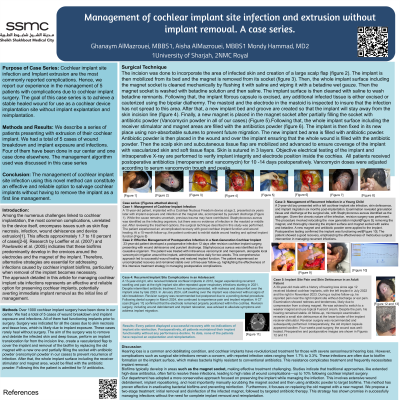Otology/Neurotology
(0944) Management of Cochlear Implant Site Infections Without Implant Removal: A Case Series
Monday, September 30, 2024
12:00 PM - 1:00 PM EDT

Has Audio
Disclosure(s):
Ghanaym Almazrouei, MD: No relevant relationships to disclose.
Introduction: Cochlear implant surgery is the most notoriously known procedure in the management of patients suffering from severe bilateral sensorineural hearing loss. Notably, cochlear implant site infection is one of the most commonly reported complications. Hence, we report our experience in the management of three patients with cochlear implants complicated by cochlear implant site infection.
Methods: From 2008 to 2018, over 800 cochlear implants surgery have been done in our center. We had a total of 5 cases of wound breakdown and implant exposure and infections. Four of them have been done in our center and one case done elsewhere. The other 3 cases consented for our proposed approach. All of them had functioning implants prior to surgery. Surgery was indicated for all the cases because of the skin necrosis and loss of tissue with implant exposure which will never heal without surgery. The aim of the surgery was to removed and debride the infected skin and deep tissue, implant translocation far from the incision line, creation of vascularized flap to cover the implant and most importantly removal of biofilm by replacing the old magnet with a new one and partially filling the socket with antibiotic powder (vancomycin powder in our cases) to prevent recurrence of infection. Then, the whole implant surface including the receiver stimulator and magnet areas would be filled with the antibiotics powder.
Results: All the patients did well without any signs of reinfection of the implant site. Patients continued to use the implant postoperatively without any decrease in performance. Most patients were followed up for more than 3 years post surgery and are still doing well with no signs of reinfection.
Conclusions: The management of cochlear implant site infection using this novel method can constitute an effective and reliable option to salvage cochlear implants without having to remove the implant as a first line management.
- GA
Ghanaym Almazrouei, MD
Ghanaym is a 3rd year otolaryngology resident in the United Arab Emirates.
SSMC
Abu Dhabi, Abu Dhabi, United Arab Emirates - MH
Mondy Hammad, MD
NMC royal Abudhabi, United Arab Emirates
